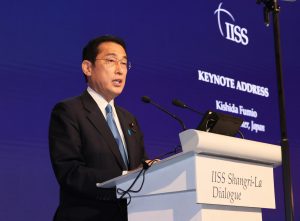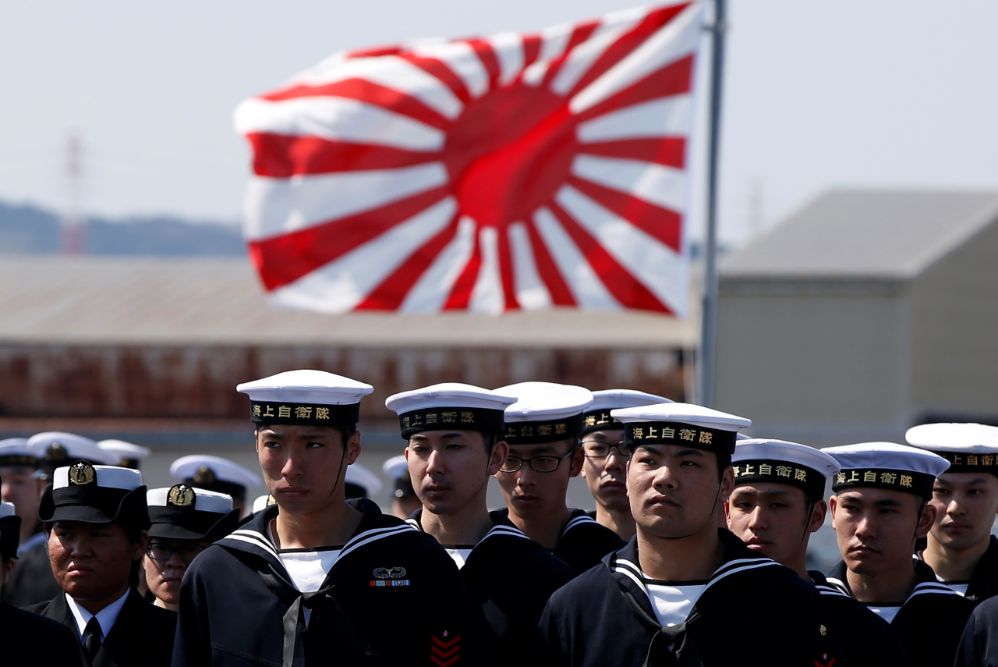Japan’s Global Leadership Gambit
Is Japanese Prime Minister Kishida Fumio proving to be as consequential a global statesman as his former boss, Abe Shinzo?

Japanese Prime Minister Kishida Fumio delivers the keynote speech at the 2022 Shangri-La Dialogue.
As the season of summitry sets in following the pandemic pause, from the Quad to NATO and the G-7 to G-20, Japan is demonstrating bold leadership. Tokyo remains determined to deliver solutions as the international community jostles with challenges to the rules-based order, both in the Indo-Pacific and Euro-Atlantic theater.
Far from the initial speculations as to whether post-Abe Japan would command the same strategic clout in the global stage, today Japan is demonstrating refreshing confidence and decisiveness on the global stage. Given the tectonic shifts in global geopolitics and geoeconomics, Japan can hardly afford not to.
It is reassuring to see that despite nuanced differences in Kishida’s and Abe’s personalities and factional politics, what’s common is their ambition to carve out a bolder role for Japan as rule of force underwrites rule of law. What has changed since Abe’s time, though, is the transformative moment in international history with Russian invasion of Ukraine.
The
pertinent question remains the same, if more urgent: When the
rules-based order is contested, how is Japan going to respond? Tokyo’s
answer is the “Kishida Vision for Peace” as articulated during the 2022 Shangri-La Dialogue. How serious are the policy discussions beyond the rhetoric?
Abe positioned Japan as the standard bearer of values, rules, and principles in important international conversations, spinning grand ideas like the Confluence of the Two Seas and Democratic Security Diamond, paving the way for the Free and Open Indo-Pacific (FOIP) and Quad. Kishida, who served as the longest serving foreign minister in the Abe administration, has over time matured as an astute leader with clear intention of scaling up Japan’s profile as a confident power.
For Kishida, it is as much about defending the rules-based international order as it is about building his own legacy beyond Abe’s towering international profile. Thus Kishida, with the aim of elevating FOIP to the next level, is churning out his own “Vision for Peace” and “Realism Diplomacy for the New Era” as Japan stands at a crossroads. Tokyo faces three fronts in Northeast Asian security with China, North Korea, and now Russia, not to mention the brewing China-Russia nexus and its impact on the power balance. With an impressive public approval rating at home, Kishida is operating from a solid ground despite the looming upper house election.
While the China-U.S. strategic competition alongside the pandemic-induced supply chain disruption posed difficult choices for Tokyo, Ukraine presented a litmus test for the leadership. Japan’s global economic leadership is already well established with Tokyo’s assiduous role in agenda-setting and rule-shaping, as seen in the Comprehensive and Progressive Agreement for Trans-Pacific Partnership (CPTPP), Regional Comprehensive Economic Partnership (RCEP), and the latest Indo-Pacific Economic Framework. However, developments in Eastern Europe are proving to be the right nudge Japan needs to fast-track its domestic security conversation and seek out a larger role in defending the foundation of international order.
How innovative is the Kishida Vision? Examining the five pillars it is anchored on may answer the question.
The first pillar is bolstering the rules-based free and open international order. This is not new. Japan has long been a resolute advocate of the rules-based international order. The FOIP conversation in Tokyo since its early days has repeatedly underscored Japan’s determination to preserve the free, open, and rules-based international order. In fact, in his 2013 “Japan is Back” speech, Abe envisioned Japan’s role as a leading promoter of rules and a guardian of the global commons.
What is innovative is Kishida’s determination to draw up a systematic “Free and Open Indo-Pacific Plan for Peace” by next spring with the aim of improving “maritime law enforcement capabilities, as well as cyber security, digital and green initiatives, and economic security.” In the next three years, Tokyo intends to expand technical cooperation and training to reinforce the maritime law enforcement capabilities of some 20 nations, train personnel on subjects of rule of law and governance, and further offer $2 billion assistance toward maritime security equipment and transportation infrastructure to fellow Indo-Pacific nations.
The second pillar is security-focused, including expanding Japan’s security role and enhancing deterrence capabilities. The incremental reorientation of Japan’s security role within the parameters of Article 9 and the right to collective self-defense is an ongoing process. The Abe years have been decisive in this regard. What Kishida has done in the backdrop of the developments around Ukraine is accelerate rather than alter the basic direction of the security conversation. Debates on doubling defense spending, counter-strike capabilities, as well as stability in Taiwan Strait in the mind space of defense planners and white papers, revision of the 2013 National Security Strategy and other defense planning predates the Ukraine war and also the Kishida administration.
What Russia’s invasion of Ukraine has done is put a definitive timeline – five years – on Tokyo’s plan of strengthening deterrence and response capabilities as Kishida’s narrative is “Ukraine today may be East Asia tomorrow.” But the challenge will be pursuing it within the parameters of Japan’s pacifist constitution. Nevertheless, the message is resonating with the Japanese public, since opinion polls show resounding support toward preparation for a Taiwan contingency. The core of Japan’s policy of external and internal balancing with the Japan-U.S. alliance at the core, and building a web of cooperation with Quad, ASEAN, and Europe remains intact. Going forward, Japan will step up its cooperation with NATO as well as the Pacific Islands as new frontiers of great power competition heats up.
The third pillar holds major significance as it is about doubling down with a sense of urgency, especially after Russia’s invasion of Ukraine, to realize a world without nuclear weapons. This is a close personal agenda of Kishida, who hails from the electoral district of Hiroshima. Northeast Asia hosts several nuclear power states. Kishida’s call encouraging both Washington and Beijing to engage in nuclear disarmament and arms control dialogue is noteworthy. His intention to become the first Japanese prime minister to participate in the NPT Review Conference demonstrates his seriousness. However, Japan’s debate and decision not to join the Treaty on the Prohibition of Nuclear Weapons highlights the complexities of the issue.
The fourth pillar pushes U.N. reforms. Japan will be joining the U.N. Security Council as a non-permanent member in 2023, which will allow it space at the high table. Reforming the U.N. has been a priority project of successive governments. Despite Japan’s significant financial contribution, its reform push has seen little success. With China and Russia holding permanent U.N. Security Council seats, it will be rough ride.
The fifth pillar anchors economic security, one of the areas where the Kishida administration has made significant strides. From enacting an economic security law to creating a full-time minister post, deepening discussions on de-risking supply chains including semiconductors, batteries, rare earth, pharmaceuticals, and protecting strategic technologies are in full steam. The conversation on economic security started gaining traction even before Kishida took office in the context of the China-U.S. strategic contest and subsequently the pandemic – for instance regulation of foreign investments in core industries, setting up of a digital agency, subsidies supporting resilient supply chains, and so on. But this effort matured under Kishida and started to deliver on policy terms.
While Kishida has presented his Vision for Peace at the Shangri-la Dialogue, how he delivers on it will be judged by history. As Japan heads for the upper house election, Kishida’s Liberal Democratic Party is expected to secure a solid mandate. This will buy Kishida time to walk the talk on his Vision. Pursuing national security interests while navigating the China-Russia-U.S. dynamics is as much a challenge as an opportunity for Kishida to define Japan’s grand strategy.





No comments:
Post a Comment
Note: Only a member of this blog may post a comment.